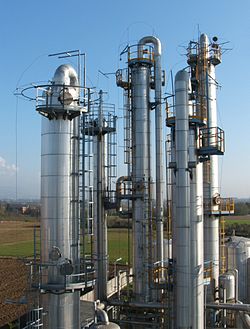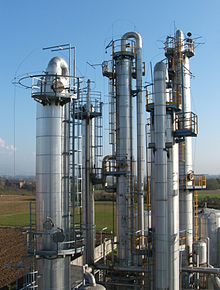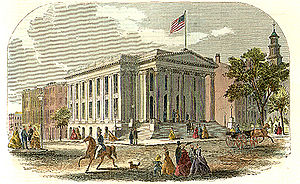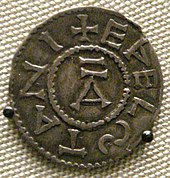CHEMICAL TECHNOLOGY
 |
| Chemical engineer design,construct and operate process plants ( fractionating columns pictured ). |
Chemical engineering is a sure type of engineering which deals with the study of operation and design of chemical plants in addition to strategies of improving manufacturing. Chemical engineers expand comparatively cheap commercial processes to transform raw cloth into beneficial products. Chemical engineering uses ideas of chemistry, physics, arithmetic, biology, and economics to efficiently use, produce, layout, delivery and transform strength and materials. The paintings of chemical engineers can range from the usage of nanotechnology and nanomaterials in the laboratory to huge-scale business techniques that convert chemicals, uncooked substances, dwelling cells, microorganisms, and power into beneficial bureaucracy and products. Chemical engineers are worried in lots of aspects of plant layout and operation, consisting of protection and chance tests, system layout and evaluation, modeling, manipulate engineering, chemical response engineering, nuclear engineering, organic engineering, construction specification, and working commands.
Chemical engineers normally preserve a diploma in Chemical Engineering or Process Engineering. Practicing engineers might also have expert certification and be accepted individuals of a professional body. Such our bodies include the Institution of Chemical Engineers (IChemE) or the American Institute of Chemical Engineers (AIChE). A diploma in chemical engineering is at once connected with all the other engineering disciplines, to numerous extents.
Etymology
 |
| George E.Davis |
A 1996 article cites James F. Donnelly for citing an 1839 connection with chemical engineering on the subject of the production of sulfuric acid. In the identical paper, but, George E. Davis, an English consultant, became credited with having coined the term. Davis additionally attempted to observed a Society of Chemical Engineering, but rather it became named the Society of Chemical Industry (1881), with Davis as its first secretary. The History of Science in United States: An Encyclopedia places the usage of the time period round 1890. "Chemical engineering", describing the use of mechanical equipment within the chemical industry, have become commonplace vocabulary in England after 1850. By 1910, the career, "chemical engineer," become already in not unusual use in Britain and the US.
History
New concepts and innovations
 |
| Demonstration version of a direct-methanol fuel cell. The real gasoline mobile stack is the layered cube form inside the middle of the picture. |
In Nineteen Forties, it have become clean that unit operations by myself have been inadequate in growing chemical reactors. While the predominance of unit operations in chemical engineering guides in Britain and the USA continued till the 1960s, transport phenomena started out to revel in more awareness.[8] Along with other novel concepts, consisting of procedure structures engineering (PSE), a "2d paradigm" became defined. Transport phenomena gave an analytical method to chemical engineering while PSE centered on its synthetic elements, consisting of control device and technique layout. Developments in chemical engineering before and after World War II had been in particular incited through the petrochemical industry; but, advances in different fields have been made as properly. Advancements in biochemical engineering in the Nineteen Forties, as an example, located utility in the pharmaceutical industry, and allowed for the mass manufacturing of numerous antibiotics, consisting of penicillin and streptomycin. Meanwhile, progress in polymer science within the Fifties paved way for the "age of plastics".
Safety and hazar developments
Concerns regarding the protection and environmental effect of big-scale chemical production facilities had been also raised during this period. Silent Spring, published in 1962, alerted its readers to the damaging outcomes of DDT, a strong insecticide.The 1974 Flixborough disaster in the United Kingdom resulted in 28 deaths, in addition to harm to a chemical plant and three close by villages. The 1984 Bhopal catastrophe in India resulted in nearly four,000 deaths. These incidents, along with different incidents, affected the recognition of the trade as commercial protection and environmental safety were given greater consciousness. In reaction, the IChemE required protection to be a part of every diploma direction that it accredited after 1982. By the Nineteen Seventies, rules and monitoring companies had been instituted in numerous countries, which includes France, Germany, and the US.
Recent progress
Advancements in laptop technology located applications designing and coping with flora, simplifying calculations and drawings that formerly needed to be carried out manually. The of entirety of the Human Genome Project is likewise seen as a primary improvement, now not simplest advancing chemical engineering but genetic engineering and genomics as properly. Chemical engineering ideas had been used to supply DNA sequences in large quantities.
Concepts
Chemical engineering entails the software of several ideas. Key standards are supplied under.
Plant design and construction
Chemical engineering layout concerns the advent of plans, specifications, and financial analyses for pilot plants, new plants, or plant changes. Design engineers regularly paintings in a consulting position, designing vegetation to satisfy customers' wishes. Design is restrained with the aid of several factors, together with funding, government regulations, and safety standards. These constraints dictate a plant's choice of process, substances, and device.
Plant creation is coordinated via mission engineers and mission managers, depending on the dimensions of the funding. A chemical engineer may additionally do the process of project engineer full-time or a part of the time, which requires extra education and job capabilities or act as a representative to the assignment institution. In the us the training of chemical engineering graduates from the Baccalaureate applications approved by ABET do not typically strain task engineering training, which may be obtained via specialised training, as electives, or from graduate packages. Project engineering jobs are a number of the most important employers for chemical engineers.
Process design and analysis
A unit operation is a physical step in an character chemical engineering technique. Unit operations (such as crystallization, filtration, drying and evaporation) are used to prepare reactants, purifying and keeping apart its merchandise, recycling unspent reactants, and controlling electricity switch in reactors. On the alternative hand, a unit manner is the chemical equal of a unit operation. Along with unit operations, unit procedures constitute a method operation. Unit approaches (which includes nitration, hydrogenation, hydrocracking and oxidation) contain the conversion of materials by biochemical, thermochemical and other way. Chemical engineers responsible for these are known as system engineers.
Process design calls for the definition of system kinds and sizes as well as how they are related and the materials of construction. Details are regularly printed on a Process Flow Diagram that is used to govern the ability and reliability of a brand new or existing chemical manufacturing facility.
Education for chemical engineers in the first university diploma 3 or four years of look at stresses the concepts and practices of method design. The identical abilties are used in existing chemical flora to evaluate the efficiency and make pointers for upgrades.
Transport phenomena
Modeling and evaluation of delivery phenomena is important for many commercial packages. Transport phenomena contain fluid dynamics, warmness transfer and mass transfer, which might be governed in particular by means of momentum switch, strength transfer and delivery of chemical species, respectively. Models frequently involve separate issues for macroscopic, microscopic and molecular level phenomena. Modeling of transport phenomena, therefore, calls for an know-how of implemented arithmetic.
Application and practice
 |
| Chemical engineers use computer to control automated system in plants. |
Chemical engineers "expand financial methods of the use of substances and power". Chemical engineers use chemistry and engineering to turn uncooked substances into usable merchandise, such as remedy, petrochemicals, and plastics on a large-scale, business setting. They are also worried in waste control and research. Both carried out and research aspects should make big use of computer systems.
 |
Chemical engineers may be worried in industry or university studies wherein they are tasked with designing and appearing experiments to create better and safer strategies for production, pollution manage, and resource conservation. They can be worried in designing and building flora as a challenge engineer. Chemical engineers serving as undertaking engineers use their expertise in selecting most efficient production methods and plant device to decrease expenses and maximize safety and profitability. After plant production, chemical engineering undertaking managers can be concerned in gadget improvements, troubleshooting, and each day operations in either complete-time or consulting roles.
English Engineering Units
Some fields of engineering inside the United States use a device of measurement of bodily quantities known as the English Engineering Units. Despite its call, the system is based totally on United States customary gadgets of measure; it isn't utilized in England.
Defination
The English Engineering Units is a gadget of consistent devices used inside the United States. The set is described via the following gadgets, with a assessment of their definitive conversions to their International System of Units counterparts
In English Engineering Units, the pound-mass and the pound-force are wonderful base devices, and Newton's Second Law of Motion
History and etymology
The term English devices strictly refers to the gadget utilized in England until 1826, while it turned into replaced by way of (extra rigorously defined) Imperial units. The United States endured to use the older definitions until the Mendenhall Order of 1893, which set up america commonplace gadgets. Nevertheless, the term "English devices" continued in common speech and became adapted as "English engineering units" however those are based totally on US commonplace devices instead of the pre-1826 English system.
A similar device, termed British Engineering Units by way of Halliday and Resnick (1974), become a system that used the slug because the unit of mass, and wherein Newton's law retains the form F = ma. Modern British engineering practice has used SI base units seeing that at the least the overdue Seventies.
Imperial and US customary measurment systems
 |
| Cincinnati Customs House c. 1850–60 Governments were one of the earliest customers of weights and measures – frequently for the purpose of tax collection. In the USA the USA Treasury instead of Congress took the lead in organising a popular machine of weights and measures. |
The imperial and US customary measurment systems are both derived from an earlier English system of dimension which in flip can be traced back to Ancient Roman gadgets of measurement, and Carolingian and Saxon units of measure.
The US Customary device of units changed into evolved and used in the United States after the American Revolution, primarily based on a subset of the English devices used within the Thirteen Colonies; it's far the primary system of gadgets within the United States. The imperial machine of gadgets changed into evolved and used in the United Kingdom and its empire beginning in 1826. The metric system has, to various degrees, changed the imperial system within the nations that when used it.
Most of the gadgets of measure have been adapted in one way or every other for the reason that NormanConquest (1066). The devices of linear degree have modified the least – the backyard (which replaced the ell) and the chain had been measures derived in England. The foot utilized by craftsman supplanted the longer foot utilized in agriculture. The agricultural foot turned into reduced to 10⁄11 of its former size, causing the rod, pole or perch to emerge as 16+1⁄2 (as opposed to the older 15) agricultural feet. The furlong and the acre, once it became a measure of the scale of a piece of land instead of its price, remained distinctly unchanged. In the closing thousand years, 3 essential pounds were utilized in England. The troy pound (5760 grains) become used for valuable metals, the apothecaries' pound, (also 5760 grains) turned into utilized by pharmacists and the avoirdupois pound (7000 grains) become used for fashionable functions. The apothecaries and troy kilos are divided into 12 oz. (of 480 grains) while the avoirdupois pound has 16 oz. (of 437.5 grains). The unit of extent, the gallon, has different values inside the United States and inside the United Kingdom – the USA fluid gallon being approximately zero.Eighty three imperial gallons and the US dry gallon being about zero.97 imperial gallons. The US fluid gallon became primarily based at the wine gallon utilized in England prior to 1826.
After the US Declaration of Independence the units of size in the United States developed into what's now referred to as normal gadgets. The United Kingdom overhauled its device of size in 1826, while it brought the imperial device of units. This resulted in the two nations having specific gallons. Later in the century, efforts had been made to align the definition of the pound and the yard in the countries with the aid of using copies of the standards followed by using the British Parliament in 1855. However, these standards were of bad quality compared with those produced for the Convention of the Metre. In 1960 the 2 international locations agreed to commonplace definitions of the yard and the pound based on definitions of the metre and the kilogram. This exchange, which amounted to a few parts per million, had little effect in the United Kingdom, but resulted inside the United States having barely specific systems of linear degree – the worldwide device, and the surveyors gadget.
English Units of measure
 |
| Silver penny of Æthelstan (924-939) from which the name pennyweight (dwt) turned into derived |
English units of degree, have been derived from a aggregate of Roman, Carolignian and Saxon units of measure. They have been a precursor to each the imperial machine of gadgets (first described in 1824, to take effect in 1826) and United States customary units which developed from English Units from 1776 onwards.
The earliest facts of English units of degree contain the weight (and therefore the fee) of Saxon coins. The penny delivered by way of Offa became approximately 20 grains (1.296 g). Edward the Elder accelerated the load of the English penny to 26 grains (1.685 g), thereby aligning it with the penny of Charlemagne. By the time of the Norman Conquest (1066), it had reduced to 24 grains (1.555 g). This fee was eventually called the pennyweight and formed the premise of the Troy units of weight—the troy ounce used to nowadays for weighting precious metals. Edward I (1272–1307) broke the link among a coin's cost and its weight when he debased the English coinage by way of introducing a groat (4 pence) which weighed of 89 grains as opposed to the expected 96 grains. The groat become in addition devalued in the 1350s whilst its weight changed into reduced to 72 grains.
 | |
During Saxon instances land became measured each in phrases of its economic fee and in terms of its length. The Domesday Book used the disguise, an monetary unit of measure. In different references the furlong and the rood appear to be units associated with ploughing procedures. Of particular hobby became the rood which become 15 North German feet in period, the North German foot being equivalent to 335 mm (13.2 inches).: 50 Craftsmen, on the other hand used a shorter Roman foot.
Standardization of weights and measures changed into a habitual difficulty for monarchs. In 965 AD, King Edgar decreed "that most effective one weight and one degree must skip at some stage in the King's dominion". In 1197 Richard I decreed that the measures of corn and pulse, and of wine and ale ought to be the identical all through all England. The Magna Carta, signed by means of King John in 1215 prolonged this to encompass cloth. Some time between 1266 and 1303 the weights and measures of England had been noticeably revised with the aid of a law called the Composition of Yards and Perches (Compositio ulnarum et perticarum) regularly referred to as the Compositio for short. This regulation, attributed to either Henry III or his successor Edward I, instituted a brand new foot that became exactly 10⁄eleven the period of the vintage foot, with corresponding reductions inside the size of the backyard, ell, inch, and barleycorn. (Furlongs remained the same, but the rod modified from 15 old toes to 161⁄2 new toes.
 |
| The standard Troy pound,destroyed in a fire in 1834 |
In 1324 Edward II systematized gadgets of length by means of defining the inch as three barleycorns, the foot as 12 inches, the yard as three feet, the perch as fifty one⁄2 yards, and the acre as a place four by way of forty perches. Apart from the ell (45 inches or 114.3 cm, which persevered for use inside the cloth change) and the chain (delivered by Edmund Gunter in 1620, and used in land surveying), those units fashioned the idea of the devices of length of the English system of measurement. The devices have been however redefined many times – during Henry VIII's time popular yards and ells product of brass had been synthetic, in the course of Elizabeth I's time these were replaced with requirements manufactured from bronze and in 1742, after medical comparisons confirmed a version of as much as zero.2% from the mean, a definitive preferred backyard changed into proposed (but now not manufactured).
During the medieval generation, agricultural products apart from wool have been frequently offered by way of extent, with diverse bushels and gallons being brought through the years for specific commodities. In the early fourteenth century the wool exchange traditionally used the avoirdupois machine of weights, a process that turned into formalized by way of Edward III in 1340. At the equal time, the stone, when used to weigh wool, turned into formalized as being 14 kilos.
During the Tudor length, numerous reforms have been made to English weights and measures. In 1496 Henry VII ordered that reference copies of the yard, pound and gallon need to be manufactured from brass and disbursed to particular cities and towns for the duration of the dominion. Many weights and measures that had crept into use had been banned: in 1527 Henry VIII banned the Tower pound (5400 grains in opposition to the 5760 grains of the apothecaries and troy kilos) and the mercantile pound (6750 grains towards the 7000 grains of the pound avoirdupois) and in 1592 Elizabeth I ordered the use of the "statute mile" (5280 feet towards the 5000 ft of the London or Old English mile).
Under the Act of Union of 1707, Scotland, which had evolved its personal system of weights and measures independently of England, deserted them in favour of English weights and measures. The Acts of Union 1800 which united Ireland with Great Britain had less of an effect on weights and measures—Irish weights and measures having been based totally at the English foot and pound avoirdupois because 1351, although the Irish acre and mile have been primarily based on a perch of 7 yards, not 5+1⁄2 yards as in England.
By the early 19th century many commodities had their personal set of gadgets, the gadgets of degree for the wool and material industries had units of degree unique to the ones commodities, albeit derived at the pound avoirdupois or the foot while wine and beer used devices with the same names but one of a kind sizes – the wine gallon being 231 cubic inches and the beer or ale gallon being 282 cubic inches. Agricultural produce become offered through the bushel which become based on but another gallon – the dry gallon of 268.8 cubic inches. Even although now not explicitly authorized via statute, many markets used bushels primarily based on weight in preference to quantity whilst promoting wheat and barley.
WRITTEN BY : ADRISH WAHEED
Labels: CHEMICAL TECHNOLOGY

0 Comments:
Post a Comment
Subscribe to Post Comments [Atom]
<< Home